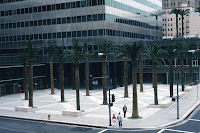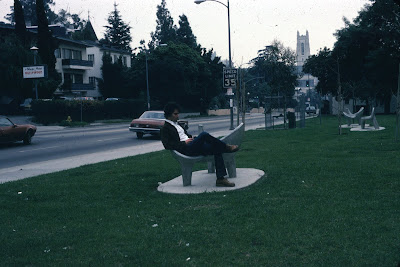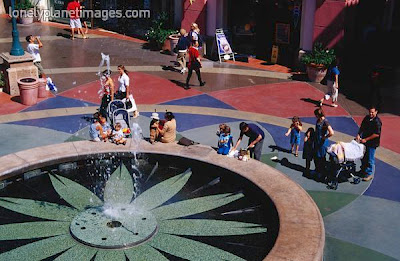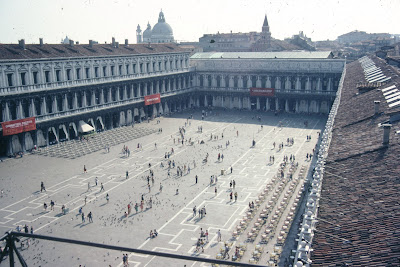| Sitting places are now a big priority for shopping centers. |
Of course, it hasn't always been this way. American cities have been very cruel to pedestrians and those who like to linger. Cities of the 1800s were dirty places, so devoid of parkland that people in big cities actually picnicked in cemeteries - often the only green spaces available. The first three quarters of the 20th century weren't much better. People with means abandoned the city for the suburbs to find their dream house. The suburbs grew so fast that there was little attention to any public spaces other than roads and an occasional park. Starting in the 1970s, some cities gave developers more floor space if they put in a plaza but many of them sat virtually unused. Then along came William Whtye, sociologist and urbanist extraordinaire!
 |
| Sociologist, urbanist, plaza guru |
Whyte was hired by the City of New York to figure out why some plazas were very active and others quite dead. He and his team of graduate students used unobstrusive observation (the old "hidden camera" trick) of hundreds of urban spaces and discovered the key elements of a good plaza. His book and film - The Social Life of Small Urban Spaces (1980) and accompanying film revolutionized the way we design plazas in this country. Here is a brief clip of his classic study - https://vimeo.com/6821934
 |
| Moveable seating is the best. |
Whyte and his team discovered that the most successful plazas had lots of sittable space (preferably movable seating), were located right next to the street and provided people with a sense of enclosure without cutting them off from the city. He found that shade and food were important amenities, but another quality he called "triangulation" - the ability of a place to connect strangers and get them talking - was even more important. These features could be street entertainment, an interesting sculpture, a spitting fountain. The City of New York liked his study so much that they totally changed their zoning ordinance to encourage those amenities which bring people together in comfort and interest.
 |
| In the 1970s and 80s, developers often added plazas to get more floors on their buildings. Can you see why many were unsuccessful? |
Whyte's study was perhaps the best example ever of applied social science research - research that improves people's lives. After his video was shown on public television, Whyte's ideas spread throughout the planning community. Previous empty spaces were enlivened. Shopping center developers realized that a comfortable place to sit might actually boost revenues. Cities began to get more serious about making their town centers comfortable again. Hooray for the planners! Bravo to William Whyte!
So, as you cruise your local town center and check out its gathering places, look for the following:
1). Is the plaza close to the street - not raised and not sunken - and can passersby see it?
2). Does it have lots of comfortable seating options?
3). Does the plaza provide a sense of visual enclosure without being cut off from surrounding areas?
4). Does it contain an interesting visual feature or focal point that draws attention?
Below you'll find mostly good examples of public gathering places analyzed from Whtye's research. His work reminds us that cities are inherently social places.
| Boulder's Pearl Street Mall is one of the best public spaces in US I have ever seen. A great space works for all ages. |
| Third Street Promenade in Santa Monica filled a large central area with dinosaur topiary to create interest and more intimate public space. |
| The City of Brea does a good job with accessible and touchable public art |
 |
| Ouch!! Good example of what not to do. Fixed benches, isolated, no sense of enclosure, orientede away from the street. |
 |
| Fashion Island's spitting fountain is sittable and highly entertaining. |
| People do not like to stop in the middle of large public places. LA's Cathedral of Our Lady of the Angels is over-scaled and totally cut off from the street. |
| Hollywood Blvd's Kodak Theatre Plaza finally gave the tourists a place to get comfortable after seeing Marilyn Monroe look-alikes at Mann's Chinese Theatre. |
| Traditionally suburban towns like San Clemente are beginning to incorporate sitting areas in their emerging town centers. |
 |
| The Europeans had a head start. St. Mark's Square in Venice has well-defined urban space and lots of movable seating. And it looks like pigeons can get people to stop in the middle of large spaces. |
| Sittability, comfort, options, sense of enclosure but still part of the urban flow. That's exactly what William Whyte documented! |
